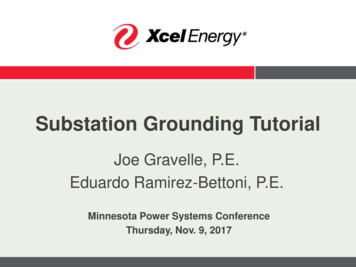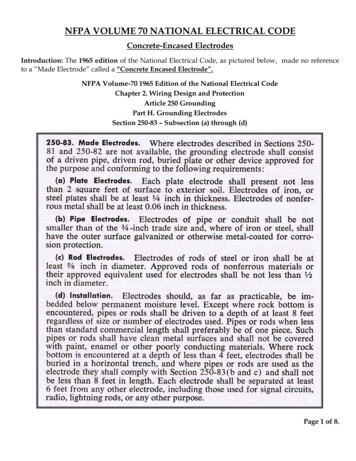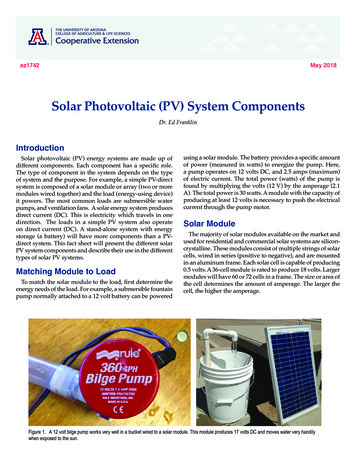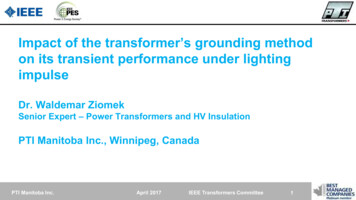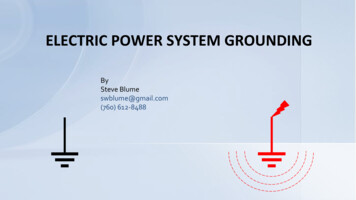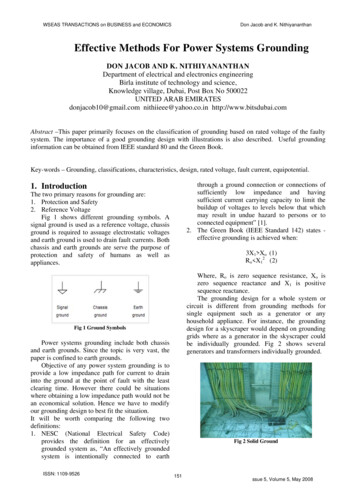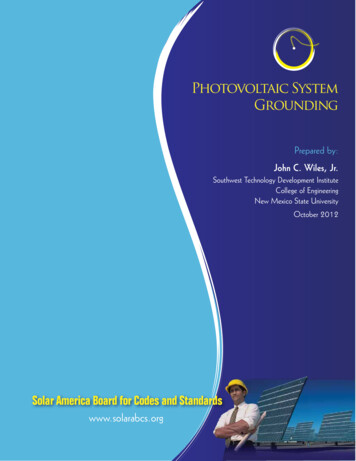
Transcription
Photovoltaic SystemGroundingPrepared by:John C. Wiles, Jr.Southwest Technology Development InstituteCollege of EngineeringNew Mexico State UniversityOctober 2012Solar America Board for Codes and Standardswww.solarabcs.org
DisclaimerThis report was prepared as an account of work sponsored by an agency of the UnitedStates government. Neither the United States government nor any agency thereof, nor any oftheir employees, makes any warranty, express or implied, or assumes any legal liability orresponsibility for the accuracy, completeness, or usefulness of any information, apparatus,product, or process disclosed, or represents that its use would not infringe privately ownedrights. Reference herein to any specific commercial product, process, or service by tradename, trademark, manufacturer, or otherwise does not necessarily constitute or imply itsendorsement, recommendation, or favoring by the United States government or any agencythereof. The views and opinions of authors expressed herein do not necessarily state orreflect those of the United States government or any agency thereof.Download a copy of the aic System Grounding
Executive SummaryPhotovoltaic (PV) power systems are capable of producing hazardous voltages andcurrents for decades. To ensure the safety of the public for these extended periods oftime, PV systems must be properly designed and installed using the highest standards ofworkmanship.This paper addresses the requirements for PV system grounding contained in theU.S. National Electrical Code (NEC ) published by the National Fire Protection Association(NFPA). The NEC and the NEC Handbook are copyrighted by NFPA and the term NFPA-70is a trademark owned by the NFPA (NFPA, 2011). It does not address in any detail thevarious American or European standards that are used to design and produce electricalequipment, nor does it cover the many electrical codes used in other countries.In the United States, the NEC establishes the legal installation requirements for PVsystems, and these requirements are somewhat complex. The NEC requires that allexposed or accessible PV equipment and circuits be properly connected to earth(grounded) using specified methods and equipment. Source circuits in PV systems maybe grounded or ungrounded as explained in this paper.As installed PV systems age, grounding issues emerge that impact system safety. Theseissues include deteriorating electrical connections, inadequate grounding device designand installation, and the effects of non-code compliant system installations. Many of therequired ground-fault protection devices in use today do not detect all possible groundfaults, and, in some cases, fires and equipment damage have resulted from undetectedground faults. Both the NEC and Underwriters Laboratories (UL) hardware safetystandards for the certification/listing of equipment are being revised to address many ofthese issues.“As installed PV systemsage, grounding issues emergethat impact system safety.Solar America Board for Codes and Standards Report”3
Table of ContentsDISCLAIMER. 2EXECUTIVE SUMMARY. 3AUTHOR BIOGRAPHY. 4SOLAR AMERICA BOARD FOR CODES AND STANDARDS. 5ACKNOWLEDGEMENTS. 5INTRODUCTION. 6DEFINITIONS. 7NATIONAL ELECTRICAL CODE REQUIREMENTS. 9SYSTEM GROUNDING. 13MICROINVERTERS AND AC PV MODULES—DIFFERENT REQUIREMENTS. 18GROUND FAULTS AND GROUND-FAULT PROTECTION DEVICES. 20THE CONNECTION TO EARTH. 25UTILITY VS NEC REQUIREMENTS. 26ACRONYMS. 27REFERENCES. 284Photovoltaic System Grounding
Author BiographyJohn C. Wiles, Jr.John Wiles is a senior research engineer at the Southwest Technology DevelopmentInstitute, College of Engineering at New Mexico State University in Las Cruces, NewMexico.He bought his first copy of the National Electrical Code (NEC ) in 1961 and rewired hisparent’s home to the latest NEC requirements. After graduating from West VirginiaUniversity with a bachelor’s degree in electrical engineering, he became an officer in theUnited States Air Force. He earned a master’s degree in electrical engineering and spent24 years in the Air Force working on automatic control systems and tactical weaponssystems. He has taught college courses at West Virginia University and the U.S. NavalAcademy. He installed his first photovoltaic (PV) power system in 1984 and has beeninvolved in the design, installation, inspection, and testing of PV systems for 28 years.He is a member of the Underwriters Laboratories Standards Technical Panels for PVmodules, inverters, racks, and direct current PV arc fault interrupters. He is secretaryof the PV Industry Forum, an organization that develops and submits PV proposals forimproving the NEC. He writes articles on PV and the NEC for the International Associationof Electrical Inspectors News and gives PV/NEC presentations throughout the country to PVdesigners, installers, and electrical inspectors. He lives with his wife Patti, two dogs, anda cat in an energy-efficient home with a 5-kilowatt utility-interactive PV system and fullhouse battery backup.Solar America Board For Codes And StandardsThe Solar America Board for Codes and Standards (Solar ABCs) is a collaborative effortamong experts to formally gather and prioritize input from the broad spectrum ofsolar photovoltaic stakeholders including policy makers, manufacturers, installers, andconsumers resulting in coordinated recommendations to codes and standards makingbodies for existing and new solar technologies. The U.S. Department of Energy fundsSolar ABCs as part of its commitment to facilitate widespread adoption of safe, reliable,and cost-effective solar technologies.For more information, visit the Solar ABCs website:www.SolarABCs.orgAcknowledgementsThe author thanks the following individuals for their critical review and comments onthis paper: Greg Ball, BEW Engineering; Ward Bower; Bill Brooks, Brooks Engineering;Marv Dargatz, Solar Edge; Jim Eichner, Schneider Electric; Marvin Hamon, HamonEngineering; Pete Jackson, City of Bakersfield; Sarah Kurtz, National Renewable EnergyLaboratory; Rhonda Parkhurst, City of Palo Alto; Dan Rice, Conergy; Michael Sheehan,Interstate Renewable Energy Council; Don Warfield, Ameresco; and Brian Wiley.Solar America Board for Codes and Standards Report5
IntroductionProper grounding of a photovoltaic (PV) power system is critical to ensuring the safetyof the public during the installation’s decades-long life. Although all components of aPV system may not be fully functional for this period of time, the basic PV module canproduce potentially dangerous currents and voltages for the life of the system. Effective,code-compliant, properly maintained grounding helps ensure the overall safety of thesystem, even if it is no longer producing usable power.More than a century ago, the United States and most of the Americas elected to usegrounded electrical systems, in which one of the circuit conductors is connected tothe earth. The rest of the world (ROW) for the most part chose to employ ungroundedelectrical systems, in which none of the circuit conductors are connected to earth. Thenormally non-energized metal surfaces of electrical equipment are, however, required tobe connected to earth in the ROW.This paper addresses the requirements for PV system grounding contained in the U.S.National Electrical Code (NEC ) published by the National Fire Protection Association(NFPA). The NEC and the NEC Handbook are copyrighted by NFPA and the term NFPA-70is a trademark owned by the NFPA (NFPA, 2011). It does not address in any detail thevarious American or European standards that are used to design and produce electricalequipment, nor does it cover the many electrical codes used in other countries.The NEC requires that the authority having jurisdiction (AHJ or electrical inspector)examine all electrical equipment for safety. Electrical equipment has generally beenstandardized from an input/output interconnectivity perspective through the NationallyRecognized Testing Laboratory (NRTL) evaluation, certification, and listing process.The NRTL certification ensures the equipment meets all applicable safety standards.Underwriters Laboratories (UL) coordinates the development of many of the safetystandards that apply to PV systems (e.g. UL 1703; UL 1741). The U.S. OccupationalSafety and Health Administration (OSHA) authorizes NRTLs to test and certify/listelectrical equipment to various standards. The American National Standards Institute(ANSI) authorizes the development of standards by UL and others. Although the NEC doesnot specifically require all equipment to be certified/listed, many local jurisdictions andmany AHJs establish requirements that all equipment be certified/listed because they feelunqualified to examine uncertified/unlisted equipment for safety as the NEC requires.6Photovoltaic System Grounding
DefinitionsBefore discussing the subject of grounding, the term “grounding” requires definition.There are two types of grounding in electrical and PV systems—equipment groundingand system grounding.Equipment GroundingEquipment grounding is known in the ROW as safety grounding or protective earthing.The equipment grounding system in the United States effectively bonds (electricallyconnects) all exposed non-current carrying metal parts of the electrical system togetherand eventually connects these metal parts to the earth (ground).Metal enclosures containing electrical conductors or other electrical components maybecome energized as a result of insulation or mechanical failures. Energized metalsurfaces, including the metal frames of PV modules, can present electrical shock and firehazards.By properly bonding exposed metal surfaces together and to the earth, the potentialdifference between earth and the conductive surface during a fault condition is reducedto near zero, reducing electric shock potential. The proper bonding to earth by theequipment grounding system is essential, because most of the environment (includingmost conductive surfaces and the earth itself) is at earth potential. The conductors usedto bond the various exposed metal surfaces together are known as equipment groundingconductors (EGCs).In a conventional electrical power system (utility, generator, or battery sourced), theequipment grounding system provides a path for ground-fault currents to return tothe energy source. By allowing these currents to return to the source in an expeditiousmanner, properly positioned overcurrent protective devices (OCPDs, typically fuses orcircuit breakers) are allowed to function, removing the source of the fault currents. TheNational Electrical Code Requirements part of this paper describes equipment groundingprocedures used in the United States.System GroundingIn system grounding, one of the circuit (current-carrying) conductors is bonded(connected) to the equipment grounding system and also to earth. This is known asfunctional grounding in the ROW. The circuit conductor that has been connected to theequipment grounding system and to earth is known as the grounded conductor. Theconnection between the grounded conductor and the equipment grounding system isknown as the system bonding jumper in the NEC. Only one system bonding jumper isallowed in each separate electrical system in which the system grounded conductor isisolated from the grounded conductors of the source or other systems. See NEC Article100 for definitions of bonding, bonding jumpers, and system bonding jumpers. Section250.28 expands on the proper installation of system and main bonding jumpers.The system ground connection, made by a system bonding jumper, is the path thatallows fault currents to return to the source. If the equipment grounding system and thesystem bonding jumper have sufficiently low impedance (i.e., proper conductor size andgood connections), currents that originate from an ungrounded conductor faulting to agrounded surface or the equipment grounding system will be sufficient to trip the OCPDsupplying that circuit. PV systems, as noted below, may not perform the same under faultconditions as other types of electrical systems.Solar America Board for Codes and Standards Report7
Earth ConnectionThe metallic device used to make contact with the earth is the grounding electrode. Theconductor that connects the central grounding point (where the equipment groundingsystem is connected to the grounded circuit conductor on grounded systems) and agrounding electrode that is in contact with the earth is known as the grounding electrodeconductor (GEC).Solidly GroundedThe NEC, in Article 100, defines solidly grounded as being connected to ground withoutinserting any resistor or impedance device in the circuit. This definition does allow forthe use of fuses, circuit breakers, and mechanical relay contacts in certain groundingcircuits, but typically precludes the use of solid-state devices such as transistors, siliconcontrolled rectifiers, and bi-junction field effect transistors. This is because these deviceswould likely be considered impedance devices. Although language in NEC 690.41 allowsequivalent grounding methods in listed equipment, no listing agencies certify products ina configuration other than solidly grounded.8Photovoltaic System Grounding
National Electrical Code RequirementsArticle 250 in the NEC covers most of the grounding requirements for any electricalsystem. This article is more than 30 pages long, and it is not possible to elaborate on orrestate all of these requirements here. Article 690 has other requirements for groundingPV systems, and many parts of the NEC are revised every three years, including Articles250 and 690. To further complicate matters, different editions of the NEC are in use indifferent jurisdictions, from the most recent edition (2011) back to the 2002 NEC andearlier versions.For the entire text of the NEC and additional explanatory material provided by NFPA,go to the NEC Handbook (NFPA, 2011). The Soares book on grounding published by theInternational Association of Electrical Inspectors (IAEI, 2011) is also an excellentresource on NEC requirements for grounding. For an individual installation, refer tothe NEC edition in use in that jurisdiction to establish specific project requirements.This paper will highlight a few of the NEC requirements for both equipment andsystem grounding that apply to PV systems and that are sometimes overlooked in PVinstallations. Unless specifically mentioned, all references to the NEC in this paper will beto the 2011 edition.Good Workmanship Is an NEC RequirementIn Section 110.12, the NEC states that good workmanship is required on all electricalinstallations. The phrase “in a neat and workmanlike manner” is not defined in the NEC,but has been addressed in other material such as the National Electrical ContractorsAssociation Standard 1. The electrical trades teach good workmanship through on-thejob-training and in more formal courses taught in International Brotherhood of ElectricalWorkers schools. The workmanship associated with the installation of PV systems iscoming under increased scrutiny by inspectors throughout the country.Unfortunately, this scrutiny has found some less than quality PV installations. Fires haveoriginated because metal conduits have not been installed properly and conductors havenot been installed properly in the conduits. Conductors have had insulation damagedduring installation, and in instances when proper grounding methods or hardware wasnot used, ground faults have occurred that led to fires. When the electrical system isnot installed properly and is not in compliance with NEC requirements, the safety of thesystem becomes questionable, either at the time of the installation or at some future dateas the system ages and deteriorates.Equipment GroundingSection 690.43 of the NEC requires that PV systems have equipment grounding systemswhen there are any exposed metal or conductive surfaces that may become energized.This requirement applies to PV systems operating at any voltage, including smallstandalone 12-volt PV systems and even a 6-volt, PV-powered water pump on a solar hotwater system. The exposed metal surfaces include PV module frames, metal mountingracks, metal conduits, and enclosures for combiners, disconnects, inverters, and chargecontrollers as well as other electrically conductive parts. Exposed conductors with failinginsulation as a result of a 40- or 50-year-old less-than-optimal installation could evenenergize a metal roof under a PV array.The emergence of PV modules with nonmetallic frames may simplify the grounding of PVmodules. The 690.43 requirement is a reiteration of the basic requirement for equipmentgrounding found in Article 250, Part VI. For a complete assessment of the state of modulegrounding according to the NEC and various UL Standards requirements, see the SolarABCs report Photovoltaic Module Grounding (Ball, Zgonena, & Flueckiger, 2012).Solar America Board for Codes and Standards Report9
In many electrical power systems, the NEC allows the use of a metallic raceway suchas EMT (electrical metallic tubing) or RMC (rigid metal conduit) to be used as the EGC.However, many PV installers and PV systems integrators choose to use a separateEGC, which would be required if a nonmetallic raceway was used. The use of adistinct conductor for the EGC is generally a good idea, because it does not rely on themechanical/electrical joints associated with metal conduit systems. Nonmetallic wiringmethods include nonmetallic rigid conduit (PVC) and nonmetallic sheathed cables (typesNM and TC).Equipment Grounding—Finer PointsPV Direct Current Circuits. Sections 690.43, 690.45, and 690.46 cover NEC requirementsspecific to the equipment grounding of PV source and PV output circuits. The basicrequirement refers to NEC section 250.110 and is outlined in the Equipment Groundingsection above. The equipment in direct current (DC) portions of the PV system maybe grounded using conductors as outlined above with appropriate connections to eachmetal surface. In general, when a copper wire is connected to a metal surface to begrounded, some sort of certified/listed grounding device must be used. This equipmentgrounding connection may be a listed ground bar kit, a standard electrical lug suitablefor the application or a terminal or lead on the equipment, or a specific grounding devicecertified/listed for the application. UL is developing a new PV racking standard 2703 (UL,2010) that will establish the requirements for certifying/listing PV racking systems asEGCs.As in other electrical systems, the rating of the OCPD protecting a DC PV circuit is usedto determine the size of the required EGC for that circuit (NEC Table 250.122). The EGCwill typically have low enough resistance or impedance to allow timely activation of theOCPD for that circuit when a ground-fault current flows through it.Although this system works for AC systems supplied by stable power supplies with highavailable fault currents, it may not be as effective for PV DC circuits. PV DC circuits havelimited available fault current that is a function of the incident sunlight energizing thesupply source and the configuration of the system (number of parallel circuits feedingthe faulted circuit). The available fault current may not be enough to enable the OCPDto function under some conditions, such as during cloudy weather or in the earlymorning or late afternoon. To address this issue, PV systems have ground-fault detectionrequirements that account for the potentially low fault current. These requirements aredescribed in the Ground Faults and Ground-Fault Protection Devices part of this paper.The current-limited nature of PV modules allows some DC circuits to be installed withoutan OCPD if there isn’t sufficient fault current to damage the circuit conductors or the PVmodules themselves. When an OCPD is not required, the rated short circuit current (Isc)for the DC PV source or output circuit is used in NEC Table 250.122 as a pseudo OCPDand an EGC size is specified by the value of that Isc. The exception to requiring OCPDon PV source circuits is usually applied to smaller residential PV systems with only onePV source circuit or two strings of parallel-connected source circuits. The exception alsoextends to PV output circuits, however, such as one or two parallel connected and equallysized combiner box output circuits.Inverters and Other Electronic Devices. UL Standard 1741 (UL, 2010) requires thatinverters have terminals, leads, or other provisions to accept EGCs for all inputs andoutputs. For a typical PV utility-interactive inverter, there should be an equipmentgrounding terminal for each DC input as well as for the AC output. These terminalsmay be on a single grounding busbar or may be physically separated but electricallyconnected. These terminals will generally be electrically connected/bonded to themetallic enclosure of the inverter. Charge controllers for stand-alone or multi-mode10Photovoltaic System Grounding
systems and PV combiners will have similar provisions for EGCs. Some microinvertersand AC PV modules as well as some DC-to-DC converters may have external terminals onthe enclosure to connect the EGCs required by the NEC and UL 1741.Conduit Bonding. When DC PV source and DC PV output circuits are installed in metalconduits, the metal conduits must have grounding/bonding bushings if the enclosuresthey connect to have concentric knockouts and if the circuits operate at more than 250volts (NEC 250.97). Many PV systems using “string” inverters have a maximum systemvoltage of more than 250 volts, and these same systems may use combiners, disconnectswitches, and inverters that have concentric knockouts. If the required grounding/bondingbushings are not installed, electrical grounding of the conduit through the fittings may belost over time. The mechanical connections between the conduit and the enclosures canloosen due to thermal and environment stresses, for example, posing a safety hazard ifground faults occur in the conduits.Enclosure Grounding. Commonly available disconnect switches and equipmentenclosures are listed devices, and are furnished with instructions and labels indicatinghow they are to be connected to the grounding system. In section 110.3(B), the NECrequires that these instructions (sometimes discarded by the electrician and the PVinstaller) and product labels be followed. The metal of these enclosures is frequentlynot sufficiently thick to hold thread cutting screws, and ordinary sheet metal screws areno longer allowed for making grounding connections (250.8). Most of these enclosureshave a label that indicates that a specific grounding bar kit be used to make equipmentgrounding connections to the enclosure. Other enclosures have a welded, threaded bossto accept EGC connections.In some cases, these instructions and labels are ignored and a lug is attached directlyto the enclosure surface, sometimes without removing any insulating finish (as250.12 requires). In other cases, a sheet metal or green thread cutting screw is usedfor grounding the box in PV applications. Neither method complies with the NECrequirements as noted in the instructions and/or on the labels for these products(110.3[B], 250.8).Aluminum Grounding. Although steel has been used for many decades for electricalenclosures, many new products from the PV Industry have aluminum enclosures.Aluminum rapidly oxidizes to an insulating surface when exposed to air. If themanufacturer has not provided a specific terminal, lead, or lug for equipment grounding,surface preparation and oxidation protection is necessary to achieve acceptableequipment grounding. This also applies to aluminum framed PV modules.Not Continuous, but Green. EGCs are not required to be continuous or to be irreversiblyspliced. They may be insulated or bare depending on the installed location. Wheninsulated, an EGC should have insulation marked or colored green or green with yellowstripes (200.119). For long-term PV system durability, colored insulations (red, white,green, etc.) should be used only when absolutely necessary, because UV radiation mayresult in a shortened life or fading colors. Most AHJs will allow exposed black insulatedEGC to be marked with a green marking if the installation requires an insulated EGC, assome do over architectural metal roofs. A proposal has been submitted for the 2014 NECto permit this marking.Routing for Performance and Safety. The EGCs for the DC portions of the circuit shouldbe routed with the circuit conductors as required by 300.3(B). Although 250.134(B) EX2 permits EGCs on DC circuits to be run separately from the DC circuit conductors, thismay not be a good practice in PV systems.Solar America Board for Codes and Standards Report11
Overcurrent devices are tested and evaluated with a minimum of circuit inductance.As the inductance in a circuit increases (increasing circuit time constant), however,overcurrent devices have an increasingly difficult time clearing the fault current andextinguishing the DC arc. The sizing requirement for overcurrent devices in PV DCsource and DC output circuits is 1.56 times the Isc. Low fault currents during periodsof low irradiance may not activate OCPD under fault conditions. The DC circuits shouldbe designed with every possible method applied to ensure the timely activation ofovercurrent devices under fault conditions. Keeping the fault circuit inductance low keepsthe time constant low and facilitates the operation of the overcurrent devices.During the operation of a single-phase inverter in the stand-alone inverting mode (eitheran off-grid system or a utility-interactive system with battery backup), the DC currentbetween the batteries and the inverter may have 120 hertz (Hz) ripple currents that are inexcess of the average DC currents. These ripple currents interact with ferrous enclosuresin the same manner as AC currents, indicating that the EGCs should be routed with theDC circuit conductors. The allowance in the NEC (250.134[B]EX2) that the EGCs in DCsystems may be run separately from the circuit conductors should not be followed in PVsystems with battery backups.12Photovoltaic System Grounding
SYSTEM GROUNDINGBefore the 2005 edition, the NEC required that all PV systems have one of the DC circuitconductors grounded whenever the maximum system voltage was more than 50 volts(690.41). Section 690.35, which allows PV systems meeting certain requirements tohave ungrounded PV circuits, was added to the 2005 NEC. This change permitted theuse of utility-interactive inverters without isolation between the DC input circuits and theAC outputs—called non-isolated inverters in the ROW—for cost savings and increasedefficiency. Most PV systems in the United States use isolated inverters with internaltransformers (isolated inverters in the ROW) as of 2012, but non-isolated inverters andungrounded PV systems are being certified/listed and are making market inroads.Note that ungrounded arrays can also be used with isolated inverters. In all cases, anungrounded array must be provided with equivalent protection for ground faults, asrequired by NEC 690.35.Grounded SystemsA PV system is defined as a grounded system when one of the DC conductors (eitherpositive or negative) is connected to the grounding system, which in turn is connected tothe earth. The conductor that is grounded usually depends on the PV module technology.Most modules can be used with a negative grounded conductor or even in an ungroundedsystem, but a few PV module technologies require the positive conductor to be connectedto earth. Note that Article 690 uses the terms “system” [690.35] and “array” [690.5]in the context of grounded or ungrounded PV DC circuits. The term “system” is moreappropriate both for consistency with AC system terminology for separately derivedsystems and for clarity. There can be multiple “arrays” feeding an inverter in which thesingle connection of the DC conductor to ground typically occurs.Color Codes. The DC grounded conductor must have insulation colored white or grayor have three white stripes if it is 6 AWG (American wire gauge) or smaller. Larger sizeconductors must be marked with these colors at their termination points. Grounded PVsource and PV output conductors 6 AWG and smaller are allowed to be marked in the samemanner as larger conductors, in order to allow the use of the durable, black-insulated USE-2and PV cable/PV wire in exposed locations within the PV array (NEC 200.6).Grounding Electrode Conductor—Installation. On ut
Academy. He installed his first photovoltaic (PV) power system in 1984 and has been involved in the design, installation, inspection, and testing of PV systems for 28 years. He is a member of the Underwriters Laboratories Standards Technical Panels for PV modules, inverters, racks, and



